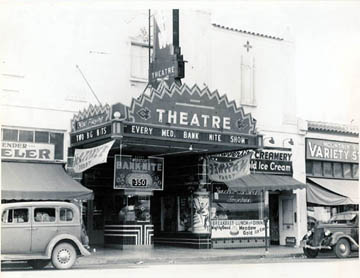

The Glen wasn't the only show in town. In 1913, an ill fated challenge was mounted by a pair of young men from San Francisco, but the Star Theatre opened and closed in the Ames Building in a span of two weeks. Apparently all the two young entrepreneurs from San Francisco had to offer was bravado and an abundance of energy. In 1917, Mr. Campen announced that due to a war tax on ticket sales, he would be forced to raise admission prices for the Glen Theatre to fifteen cents for adults and ten cents for children. The Glen Theatre went through improvements throughout its life. In 1914, a plate glass window was added to the front of the ticket booth to protect the ticket seller from the weather. I'm sure Anna Campen would have appreciated this but she had already left the theater to run Mountain Views post office by that time. A Wurlitzer organ was installed in 1921 to bring sound and added emotion to the silent films showing on its screen. The building was also expanded to accommodate larger crowds.
The Glen Theatre closed in 1926 when the new Mt. View theatre premiered. In 1933 Campen remodeled the old Glen Theatre building into a building that would house a bicycle store and one other business.The original Glen Theatre building was destroyed by a fire in April of 1949. Later in 1949 Campen replaced the damaged structure with a new building that would house a flower shop and a music store. Today, building houses the Castro Street Bar and Grill.

An early photograph of the Campen-owned Mt. View Theater |
By 1924, Fritz Campen Jr., decided that the movie business needed a larger building that was designed for, and dedicated to, showing 'moving pictures'. He began a two-year odyssey to win approval for the construction as he fended off rival businessmen inclined to construct movie houses in direct competition with him. He asserted that Mountain View could not support more than one movie house but persevered with his dream of a building a movie palace. Clearly, that wasn't enough. Campen moved forward with his plans and purchased land at 224 to 230 Castro (the address changed over the years) for his new theater. He contracted with a San Francisco architect and local resident, Alexander Canton, to design the building. Campen opened his state of the art theater on May 8, 1926, showing the Marshall Neilan directed MGM film Mike, starring Sally O'Neill, William Haynes, Ford Sterling (of Keystone Kop fame), and comedian Charlie Murray. The next feature to follow was Rin-Tin-Tin, starring John Harron and June Marlowe.
The new theater boasted several cutting edge features: modern electrical and lighting equipment, spacious rows, the best in comfortable chairs (the Mountain View Register Leader compared them to parlor chairs), and an indirect lighting system. The theater could house a crowd of 800 attendees. The Mt. View Theater witnessed the momentous transition from silent to 'talkie' films in the late 1920's. By January 1, 1929, Fritz Campen decided it was time to move his financial fortunes on to other enterprises and he sold his business to Anthony Blanco, who owned theaters in several south bay cities. |
[Home] [News & Notes] [The Features Page] [The Store] [At the Movies]
[The Calendar] [Silent Era Facts] [Silent Star of the Month]